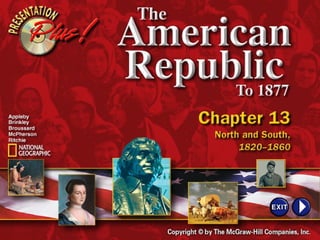
Ch. 13.2 pp
- 2. Why It Matters At the same time that national spirit and pride were growing throughout the country, a strong sectional rivalry was also developing. Both North and South wanted to further their own economic and political interests.
- 3. The Impact Today Differences still exist between the regions of the nation but are no longer as sharp. Mass communication and the migration of people from one region to another have lessened the differences.
- 4. Northern Factories • Factories produced items such as shoes, watches, guns, sewing machines, and agricultural machinery in addition to textiles and clothing. • Working conditions worsened as factories grew. • Employees worked an average 11.4-hour days, often under dangerous and unpleasant conditions. • No laws existed to regulate working conditions or to protect workers. (pages 391–393) Click the mouse button or press the Space Bar to display the information.
- 5. Northern Factories (cont.) • By the 1830s workers began to organize to improve working conditions. • Trade unions, or organizations of workers with the same trade or skill, developed. • Unskilled workers also organized due to poor working conditions. (pages 391–393) Click the mouse button or press the Space Bar to display the information.
- 6. Northern Factories (cont.) • Skilled workers in New York City went on strike or refused to work in the mid- 1830s. • They hoped for higher wages and a 10-hour day. • They formed the General Trades Union of New York. (pages 391–393) Click the mouse button or press the Space Bar to display the information.
- 7. Northern Factories (cont.) • Although the North did not have slavery in the 1830s, it did have racial prejudice and discrimination. • In 1820, although New York stopped requiring white men to own property in order to vote, few African Americans could vote. • In fact, Rhode Island and Pennsylvania passed laws prohibiting free African Americans from voting. (pages 391–393) Click the mouse button or press the Space Bar to display the information.
- 8. Northern Factories (cont.) - Free African Americans were not allowed to attend public schools and were barred from public facilities. - They were forced into segregated schools and hospitals in most communities. - A few African Americans were successful in business. - Most, though, were extremely poor. (pages 391–393) Click the mouse button or press the Space Bar to display the information.
- 9. Northern Factories (cont.) • Women were discriminated against in the mills and factories even though they played a major role in the development of industry. • They worked for less pay, were excluded from unions, and were kept out of the workplace to make more jobs for men. - The Lowell Female Labor Reform Organization in Massachusetts petitioned the state legislature for a 10-hour workday in 1845. - The legislature did not even consider the petition signed only by women. (pages 391–393) Click the mouse button or press the Space Bar to display the information.
- 10. The Rise of Cities • People moved to the cities to fill the factory jobs. • In 1860 the population of New York City, the nation’s largest city, passed 800,000. • Philadelphia had more than 500,000 people. • City life was often difficult and dangerous due to overcrowding, run-down buildings, and the threat of disease and fire. (pages 393–395) Click the mouse button or press the Space Bar to display the information.
- 11. The Rise of Cities (cont.) • Immigration to the United States greatly increased between 1840 and 1860. • Many of these people were willing to work for low pay and long hours. - The largest group came from Ireland, more than 1.5 million, settling mainly in the Northeast. - A potato famine, or an extreme shortage, caused by a potato disease destroyed Ireland’s crops, and starvation followed. - Potatoes were the staple food of the Irish diet. (pages 393–395) Click the mouse button or press the Space Bar to display the information.
- 12. The Rise of Cities (cont.) - The men from Ireland worked in factories or did manual labor such as working on the railroads and digging ditches. - Women became servants and factory workers. - The second-largest group of immigrants came from Germany. They settled in New York, Pennsylvania, the Midwest, and the western territories. - Some came for new opportunity, and others came as a result of the failure of the democratic revolution in 1848. - More than one million came, many in family groups. Many had money, so they prospered, founding their own communities and organizations and buying farms or setting up businesses. (pages 393–395) Click the mouse button or press the Space Bar to display the information.
- 13. The Rise of Cities (cont.) • Immigration changed the character of the country. • People brought their language, customs, religion, and ways of life. • Most of the Irish immigrants and about one- half of German immigrants were Roman Catholics. • They settled in northeastern cities. • The church gave them a source of spiritual guidance and also provided a center for community life. (pages 393–395) Click the mouse button or press the Space Bar to display the information.
- 14. The Rise of Cities (cont.) • The immigrants faced prejudice. • Anti-immigrant feelings arose. (pages 393–395) Click the mouse button or press the Space Bar to display the information.
- 15. The Rise of Cities (cont.) • The Know-Nothing Party wanted stricter citizenship laws and wanted to ban foreign- born citizens from holding office. • In the mid-1850s, the movement split over slavery. • A Northern branch and a Southern branch formed. • Slavery also divided the Northern and Southern states. (pages 393–395) Click the mouse button or press the Space Bar to display the information.